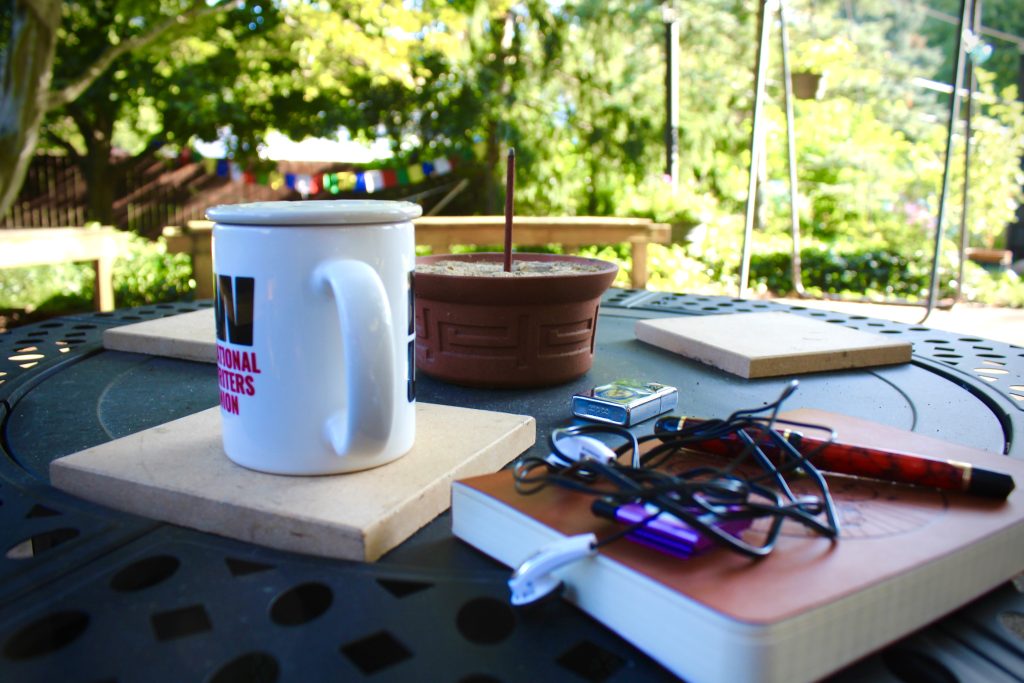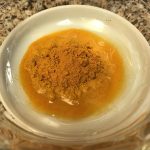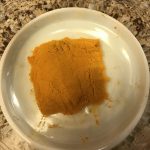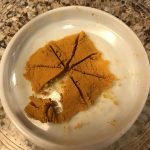In decent weather, I like to take my morning meditation outdoors. What a blessing on these cool, crisp, late summer days.
New Recording of The Lokah Invocation
Brian’s recording of the Lokah Peace Prayer is now available on the major streaming services world wide.
More information is available on the Sharanam Records site.
May all beings everywhere be happy.
Making Turmeric and Neem Balls
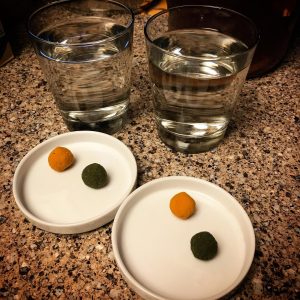 After hearing Sadhguru speak about the benefits of daily consumption of Neem and Turmeric on an empty stomach each morning, I decided to give it a try.
After hearing Sadhguru speak about the benefits of daily consumption of Neem and Turmeric on an empty stomach each morning, I decided to give it a try.
I ordered a bag of organic Turmeric powder from Organic Spice Resource, and a bag of Neem from Chaqyr (both on Amazon) in November of 2023, and my wife and I have both been taking these in the morning ever since.
Honestly, we haven’t noticed any dramatic effects to report, but it’s a simple enough thing to do for one’s health, and the benefits of both of these substances have been documented by Western science as well as Vedic tradition.
It takes me about twenty minutes to make enough of these for four days for the two of us. Here is a quick outline of the process.
Mix 1 teaspoon of powder into 1 teaspoon of water in a small bowl. I use a fork to mash up the mixture into a sort of dry paste.
Once the powder and water are mixed together, I use my fingers to pull it together into a square or circle in the middle of the bowl. It helps to have the fingertips a little wet.
I use a paring knife to score it into eight even portions, and then roll each portion between thumb and forefinger to shape into balls a little smaller than a marble.
Then repeat the process with the other variety of powder.
Depending on the brand of powers you purchase, you may have to play around with the ratios a bit. I’m finding that I need to use a little more powder than a teaspoon with the Neem from Banyan Botanicals in order to get the right consistency.
These keep well in an airtight container in the fridge. Leaving them at room temperature more than overnight is not recommended. I had a batch get moldy after several days unrefrigerated.
If you try these, I’d love to hear back from you about your experience with them.
Meditation Workshop Saturday September 21st, 2024
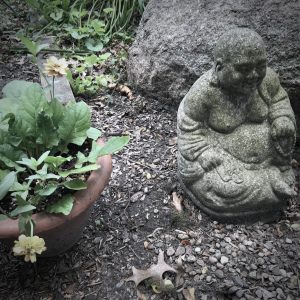 Join us at 1 PM on Saturday, September 21st at Kankakee Arts CoLab for an introduction to meditation.
Join us at 1 PM on Saturday, September 21st at Kankakee Arts CoLab for an introduction to meditation.
Establishing a daily meditation practice is one of the simplest things we can do to enhance our well being. It offers a wide range of benefits to our physical health, emotional balance and spiritual growth.
In this short introductory workshop, you’ll learn about the various types of meditation, the benefits of the practice, a little about related science and philosophy – and will get a chance to try two simple meditation techniques that you can use to begin your own practice.
This workshop is offered free of charge. Donations to Kankakee Arts CoLab are welcome.
Time: 1 PM to 2:30 PM – 21 September 2024
Location: Second Floor of the Majestic, 150 N. Schuyler Ave., Kankakee
Dress: Casual and Comfortable
Bring: If you’d like to take notes, you’re welcome to bring tools for that, and a beverage if you would like. There’s no need to bring anything else.
Facilitator: Brian is a daily meditator and TMO Certified Meditation Teacher who has studied numerous meditation styles and techniques. Meditation has helped him to get sober, reclaim his health, lose 90 pounds, and learn to be a kinder, more joyful human.
Questions? Email Brian to noebie@gmail.com.
Saturday Morning Hanuman Chalisa
On Tuesdays and Saturdays, it is my habit to sing the Hanuman Chalisa as part of morning devotions. I learned this beautiful prayer during the early days of the pandemic, listening to livestreams from Devadas.
Here is one of my favorite of Shri Tulsidas’ stanzas.
rāma duāre tuma rakhavāre
hota na ājñā binu paisāreYou are the guardian at the door of Ram’s abode, no one enters without your leave.
Hanuman is the personification of devotion. This verse tells us that without devotion, we cannot approach the indefinable, imperishable, unchanging state of consciousness that we usually refer to as God.
I would highly recommend this commentary from Paramahamsa Prajnanananda if you’d like to learn more about this powerful prayer.
If you’d like to learn the words and chant along, here are links to transliterations and English translations.
Hanuman Chalisa (Nina Rao’s Website)
Hanuman Chaleesa (Krishna Das Website)
राम राम
A Peak Meditation Experience
In September of this year, I attended a week-long retreat with my meditation teacher, Ryan Kurczak. The group in attendance meditated together for several hours each day, listened to discourses, enjoyed being out in nature at the lovely Laurelville Retreat Center, and had some time to just unplug and unwind from our responsibilities. On Thursday Evening Ryan conducted a beautiful Kriya Yoga Initiation. The entire week was a blessing, and an opportunity to deepen and strengthen our practice.
On Friday Morning, there was to be one final group meditation session before breakfast and the last Q&A of the week. I looked forward to the morning as a sort of summing up and farewell, but didn’t expect anything particularly profound or special. I had it figured that the prior night’s initiation was the highlight of the week, and that we would enjoy our last hours together and be on our way.
We gathered at 7 AM, and Ryan led us through a guided meditation, involving chanting through the chakras. There was nothing unusual about his demeanor, or the atmosphere in the meditation space. It did not seem that there was anything new or unique from what we had done all week.
At some point, as nearly as I can recall, he encouraged us to feel as if our shoulders and head were becoming light. A moment later I felt as if I was floating through a field of blue. My entire field of vision was filled with deep, bright blue, similar to this image.

The light was so intense, that I opened my eyes to see if someone had actually turned the lights on in the room. They had not.
I don’t remember his other words, or much else at all about the meditation from that point forward, except for the experience of feeling weightless, and expansive, and joyful, and filled with light. In my younger years I spent a great deal of time using various intoxicating substances, and not once did I ever feel so high as I did on that Friday Morning.
He eventually coached us back to feeling more grounded in our bodies, the meditation was ended, and we headed to the dining hall for breakfast.
I was still a little disoriented for awhile. I remember trying to describe to my wife what had just happened, and finding it hard to put into words. I was holding the door for some other folks at the dining hall when Ryan arrived, and I remember looking him in the eyes and mumbling “Holy shit, Ryan.” He just chuckled and went on inside.
I wondered if Ryan had somehow planned this experience for the final morning of retreat. I’ve read many accounts of folks’ experiences with their gurus where this sort of thing happened. A touch on the forehead and they’re propelled into indescribable bliss.
It was so intense that I remember thinking that this must be the sort of thing that sometimes prompts people to toss their discretion out the window and follow a teacher or guru into unhealthy or cultish situations.
For Q&A that day, I asked about the experience. I mentioned that it had been almost terrifyingly profound, and asked if he knew this was going to happen, or if it’s something that he had “done to us” intentionally. He replied that he didn’t plan anything, that sometimes things just happen. He did not attempt to take credit for the experience, or claim any special powers or such. It’s just the sort of thing that can happen with regular practice.
He did encourage us to make note when we have an experience like this, so that we can remember it and use it as inspiration to continue on the path.
Since returning from retreat, I’ve not experienced anything quite so intense, but I’ll keep practicing. That Friday Morning gave me a glimpse into the great unknown, and I believe that I’d like to have a closer look.
The Cowboy Mahamantra
I’ve been singing this melody of the Mahamantra for a couple years now. I thought it might be fun to produce a recording of it with a full complement of instruments. At first, I was going to assemble a combo to play, but then decided I’d try to play all of the instruments myself, just to see if I could do it. This involved learning to play some things that I had absolutely no prior experience with, so I kept the parts (especially the percussion instruments) as simple as possible.
The choir was “friend-sourced” on Facebook and Instagram. I was happy to find a dozen folks who were willing to sing along and send me their recordings, and it was a lot of fun mixing all of those together to resemble an actual live Kirtan.
I have no goals or aspirations for the recording, except to spread the joy of singing this mantra. I do hope that it finds its way to someone who will be helped in some way by hearing it, and perhaps singing along.
Notes of Thanks
Thanks to our friends who responded to the call for crowdsourcing the choir. What I heard in my head was a diverse, un-reined choir of loving voices, and that’s exactly what they gave me. I’m so grateful.
Special thanks to Eban Crawford for his advice in tweaking the final mix. He’s not only a talented and highly skilled composer, guitarist, multi-instrumentalist, recording engineer and producer. He is the rarest of creatures in our day and age: a straight shooter with a heart as big as the sky. Thanks, Pal!
To my wife and offspring, who patiently endured listening to this recording in various iterations ad nauseam for the past three months, thanks for the love, encouragement, patience and constructive feedback. Also, special thanks to Claudia who first started me down a Kirtan rabbit hole three and a half years ago. You’ll always be my favorite singing partner, Sweetheart.
To the devotees of every place and time who have shared and spread this sweet, sweet practice of Bhakti, we owe you an inestimable debt.
Finally, to the Lord who creates us, sustains us and takes us back home – to the Lord who is always with us, but is also beyond the beyond – we make our offerings to the One who leads us from darkness to light. It is to You that we bow, and offer our lives.
Credits
Lyrics: The Great Mantra from the Kali-Saṇṭāraṇa Upaniṣad
Hare Krishna Hare Krishna
Krishna Krishna Hare Hare
Hare Rama Hare Rama
Rama Rama Hare Hare
Melody: Brian Noe
Acoustic Guitars, Bass, Slide Guitars, Mridanga, Kartals, Vocals: Brian Noe
Kirtan Response Choir: Dustin Cormier, Michael Deathrow, Dani Kindleyside, Brigita Lajkovic, Donelle Mason, Julie McDonald, Claudia Noe (times two!), Kristin Ponnambalam, Brian Prairie, Cathleen Rittereiser, Beth Rockert and Marilyn Starkenberg
Wise Counsel: Eban Crawford
Production and Mix: Brian Noe
Chant and Be Happy!
ॐ†
You can download the audio of the song for free at this link.
https://archive.org/details/the-cowboy-mahamantra
Also available on BandCamp, with any proceeds going to Neem Karoli Baba Ashram in Taos.
https://noebie.bandcamp.com/track/cowboy-mahamantra
Coming soon to iTunes, Amazon Music and all the other places. 🙂
A Short Biographic Video of Mahavatar Babaji
YouTube’s algorithms brought this little gem to my attention. It actually does a decent job of conveying who Babaji is, and what he taught, all in under ten minutes.
What struck me about the video, though, is that at about 7:20 in there is a visual effect that very closely approximates what I see during Kriya Yoga meditation. I suspect that the similarity is merely coincidental, but still, it took my breath when it appeared on the screen
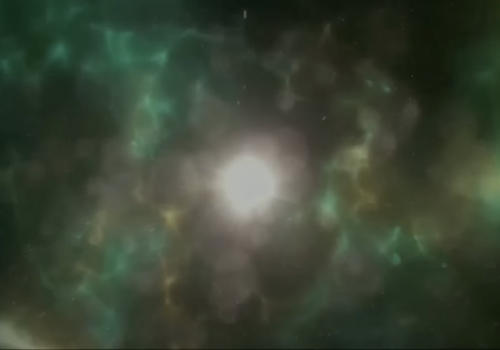
I first noticed these clouds of light converging in the center of my field of vision occasionally in late 2019 during TM style silent mantra meditation. I learned later, as I began to practice Kriya Yoga, that the phenomenon sometimes accompanies the opening of the Spiritual Eye as one enters the superconscious (or transcendental) state. This occurrence has become more commonplace during Kriya Pranayama over the past few months, after having practiced the technique for a couple of years now.
For more information on Mahavatar Babaji’s legacy, and the practices of his Kriya Yoga lineage, I would highly recommend the Kriya Yoga Online YouTube channel of my teacher, Ryan Kurczak.
Remembering George Harrison
Today we remember George Harrison on the 80th anniversary of his birth.
“Everything else can wait but the search for God cannot wait.”
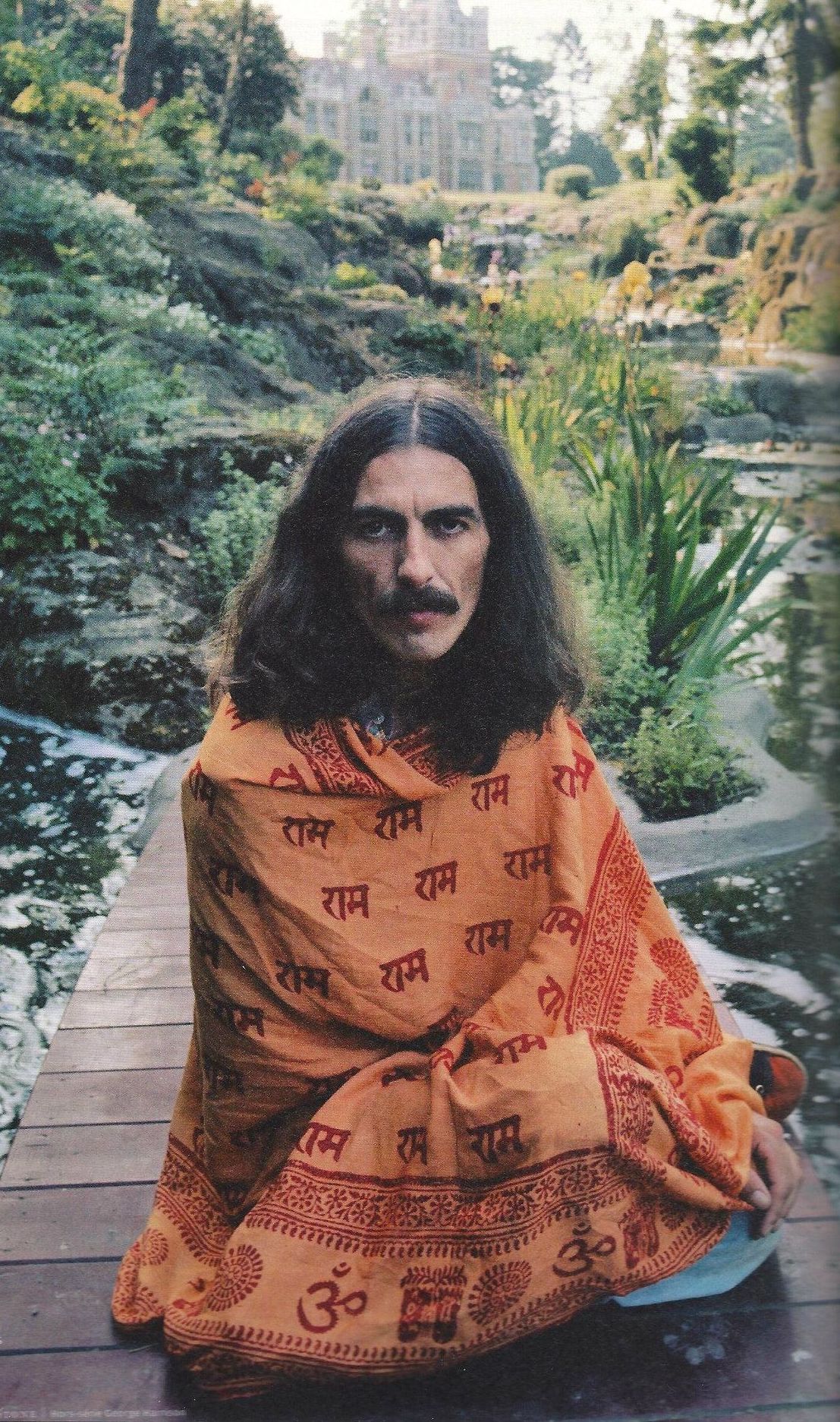
Nadi Shodhana
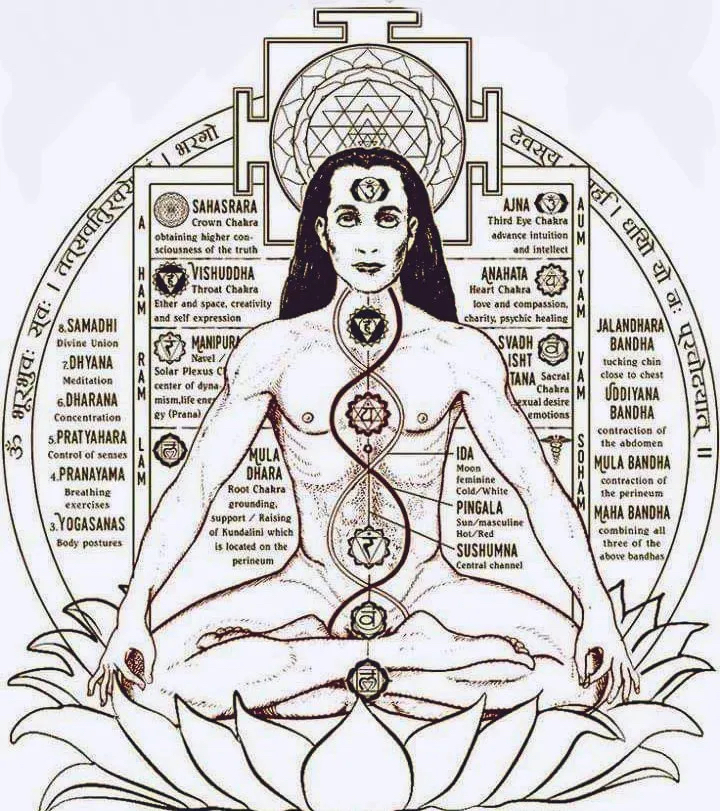 When we sit to meditate, we attempt to still the fluctuations of the mind. Sometimes we do this by placing our attention on an object of meditation, which can be a physical object like a candle flame or murti, or something more subtle, like a mantra or even our own patterns of breathing.
When we sit to meditate, we attempt to still the fluctuations of the mind. Sometimes we do this by placing our attention on an object of meditation, which can be a physical object like a candle flame or murti, or something more subtle, like a mantra or even our own patterns of breathing.
Simply placing our attention on the breath as we inhale and exhale can be a powerful meditation technique. Part of the power of this practice is that it goes beyond “quieting the mind.” As we watch the breath rise and fall, we are actually working with our life’s energy pathways. This is called “pranayama.” Although this term is often translated as “breath work” or “breath control,” attention to the breath is really just the vehicle for direction or influence of the life force energy, prana.
In the West, we tend to think of the “nervous system” as something materially tangible, like the wiring of a house. In India, the emphasis goes beyond the physical structure to the flow of energy itself. It’s as much about the electrical current as it is the wiring.
Our patterns of current or life force energy can be thought of as pathways, roughly corresponding to the structure of our physical nervous system. The representation of these patterns or flows of energy are called the nadis.
What are the Nadis?
Nadi is a Sanskrit word for “channel.” The tributary channels of pranic energy in our system converge in patterns that form three main channels which weave around what we know as the Chakras (our seven major cerebral and spinal energy centers).
In Kriya Yoga practice, much attention is given to the Sushumna Nadi, which is the central, spiritual energy channel that corresponds most closely in location with the spinal cord, and represents the most direct journey of energy between the first chakra and the crown.
For energy to flow effectively through the central channel, the other two channels must also be balanced and free of blocks. These channels are:
1) The Ida Nadi, which flows to the left from the Root Chakra, weaving around the chakras until it terminates in the left nostril. This nadi is considered the left channel, and rules the left (or lunar) side of the body; and,
2) The Pingala Nadi, which flows to the right from the Root, terminating at the right nostril, ruling the right (solar) side of the body.
At the very beginning of nearly every meditation session, I spend some time breathing in a strategic way to clear and open these twin energy channels. This pranayama technique is called Nadi Shodhana. The phrase means “channel clearing” but it is often rendered in English as “alternate nostril breathing” (for reasons that should become obvious as you read the description of the technique). Some traditions call the practice “purifying breaths.”
Nadi Shodhana Technique
Sit quietly and relaxed with your spine straight. Close your eyes and take a few soft, deep breaths.
- Bring your right hand up so that your palm is in front of your mouth. Your index and middle finger will be just in front of your forehead, right above the eyebrows.
- Press your thumb in gently on the right side of your nose, blocking off the passage of air, and inhale through your left nostril. As you inhale, place your attention on the rising of the breath, and the left side of your body.
- Release your thumb from the right nostril, and press the tips of your ring finger and pinky into the left side of your nose to block the passage of air. Exhale, feeling the air moving out through your right nostril, and the sensations on the right side of your body. Pause briefly before inhaling and sensing the breath rise on the right side again.
- Finally, switch sides with your fingers and thumb once more and complete the cycle by exhaling through the left nostril as the breath descends on the left side of your body.
This four-step process of breathing in left, breathing out right, breathing in right, breathing out left is considered one cycle of Nadi Shodhana. Most of the time I will do twelve cycles at the beginning of a meditation session (although for Green Tara Sadhana instructions are specific to do nine purifying breaths at the beginning). The cycles can be counted on your free hand, using the twelve finger bones in that hand as if they were mala beads. Move your thumb to the next bone as you complete a cycle. When you reach the tip of the last finger, you’ve done twelve cycles of Nadi Shodhana.
Benefits of Nadi Shodhana
From an immediate, practical standpoint the practice of alternate nostril breathing as described above brings an almost instant sense of calm and centeredness. Respiration and heart rates decline, anxiety dissipates, cortisol and cytokines are reduced, oxytocin is released. Even five minutes of practice can reduce stress and increase mental focus. Over time, longer or more frequent practice (and incorporating other techniques such as mantra meditation) can quell inflammation, reduce blood pressure, relieve depression, enhance memory and mental clarity, promote optimism, stimulate creativity and generally improve one’s outlook and quality of life.
Beyond the immediate benefits, for the committed yogi, clearing these channels is essential preparation for more intense practices such as Kriya Yoga Pranayama, where the life force is directed to the higher cerebral centers in search of awakening, liberation and consciousness of God.
Resources
Here’s a great, short demonstration of the practice from Banyan Botanicals.
There’s also a good thread on the Nadis from V Shuddhi on Twitter.
My teacher, Ryan, also speaks about alternate nostril breathing in this video about preparing for Kriya Yoga Initiation as he describes the Kriya Meditation that he was taught by his guru, Roy Eugene Davis.
I’d love to hear from you with questions, or your own experiences with Nadi Shodhana and other pranayama practices. Leave a comment below or hit me with an email.
- 1
- 2
- 3
- …
- 6
- Next Page »
